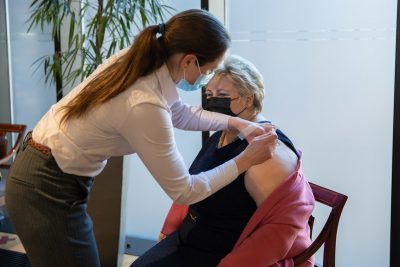Prime Minister Erna Solberg’s announcement that her government will stop using the AstraZeneca vaccine, make the Johnson & Johnson vaccine optional and shake up Norway’s entire vaccination program was getting a mixed reaction Wednesday evening. Young Norwegians aged 18-24 were glad they’ll be getting priority, but many cities don’t want to give up their vaccine allotments to others where infection rates are higher.

Solberg, who recently got her own first shot, rolled out some major changes in Norway’s vaccination program at a press conference Wednesday evening. Her government’s formal decision to remove the AstraZeneca vaccine entirely was expected: It’s been suspended since doctors tied some serious side-effects to it earlier this spring, and both health authorities and a government-appointed commission have recommended against using it. They don’t want any more otherwise healthy Norwegians to develop blood clots, internal bleeding and even fatal cerebral hemorrhages that have been linked to its use.
Johnson and Johnson, meanwhile, took its vaccine off the market after some reports in the US of similar side-effects. Millions of others, however, haven’t suffered any and now it will eventually be made available to Norwegians on a voluntary basis.
It was a bigger surprise when Solberg announced that Norwegians aged 18-24 will soon jump to the head of the vaccine queue in Norway. The government had earlier gone along with the public health institute FHI’s plan to systematically vaccinate Norwegians from the oldest to the youngest, meaning the 18- to 24-year-olds would be the last to get their shots. Those with serious underlying health problems have also had priority regardless of their age.
Now those in the 18-24 age group will get precedence over those aged 25 to 39, who are being pushed to the end of the queue. The youngest age group will be called in for their first shots at the same time as the 40- to 44-year-olds, who currently are next in line to be vaccinated. The 25- to 39-year-olds will be last.
That’s in line with FHI’s recommendation and based on concerns that infection in Norway is currently highest among the young. They’ve also arguably suffered the most during the pandemic, with high schools, colleges and universities mostly closed, their degree programs disrupted and their social lives all but ruined. New studies have shown that they can also tend to get sicker than slightly older Norwegians, and have a higher chance of landing in the hospital.
Now, Solberg said, “if the vaccination program continues according to (the new) plan, everyone over age 18 will have been offered a vaccination by the end of July or early August.”
Several interviewed after the news broke were happy indeed, with two young men living near Horten expressing relief and gratitude. They were glad Solberg recognized that many in their age group have had a difficult time during the pandemic.
Solberg also released news, just as Norway was heading into a five-day holiday weekend, that her government was going along with FHI’s recommendation to continue allocating more vaccine to geographic areas where infection is highest. That means Oslo, widely viewed as the pandemic’s epicenter in Norway, and other hard-hit areas in southeastern Norway will keep getting more vaccine than other areas.
That was not well-received in areas that recently have also had outbreaks, albeit not as bad as in the southeast. Tønsberg Mayor Anne Rygh Pedersen of the Labour Party was furious that her city will have to turn over some of its vaccine share to other towns and cities.
“This is not right,” Pedersen told NRK. “I’m not willing to give up doses to other areas given the situation in our city now.” She said infection levels in Tønsberg have been rising, with the number of confirmed cases last week double that of the week before. “I could understand it when earlier priorities were set, but not now,” Pedersen said. “I say this on behalf of the people of Tønsberg, because we are now in a very uncertain situation.”
“Extremely unfair”
Solberg, however, said that 309 municipalities around Norway will, over the next seven weeks, need to give up an average of 35 percent of their vaccine allotments. They include Ålesund and Porsgrunn, both of which have had outbreaks in the past week or two. Their mayors weren’t happy either: “This seems extremely unfair,” claimed Robin Kåss, a doctor and mayor of Porsgrunn, where partying high school graduates have played a role in setting off another wave of infection in the past week.
It seemed to be little comfort to either Kåss or Pedersen that some of their vaccine allotments will be sent to Oslo where fellow top Labour Party politician Raymond Johansen leads Oslo’s city government. Johansen has pleaded for more vaccine in Oslo for months, and is now getting it.
The cities of Drammen and Lillestrøm, also led by Labour mayors, are among those set to get more vaccine, too. “This is what we’ve been asking for and we’ve been heard and understood,” Lillestrom Mayor Jørgen Vik told NRK. “We are very glad.” So was Drammen Mayor Monica Myrvold Berg: “I’d hoped this would happen. Everyone wants their residents to be vaccinated.”
Most all towns and cities from Halden and Fredrikstad in the south to Rælingen and Enebakk in the east, Eidsvoll and Nittedal north of Oslo and Asker and Bærum to the west are due to get more vaccine doses. Other larger Norwegian cities like Bergen, Stavanger, Trondheim and Kristiansand are due to get the same amount of doses as they’ve had.
Solberg also added that Norway’s allotment of the AstraZeneca vaccine will now be sent back to other countries in connection with Norway’s vaccine agreement with the EU. “It’s important that these doses quickly get to other countries where they’re needed because of high infection levels,” Solberg said. It remains unclear why some Norwegians reacted badly to the AstraZeneca vaccine, leaving Norway with the highest per capita rate of serious side effects in the world.
newsinenglish.no/Nina Berglund

